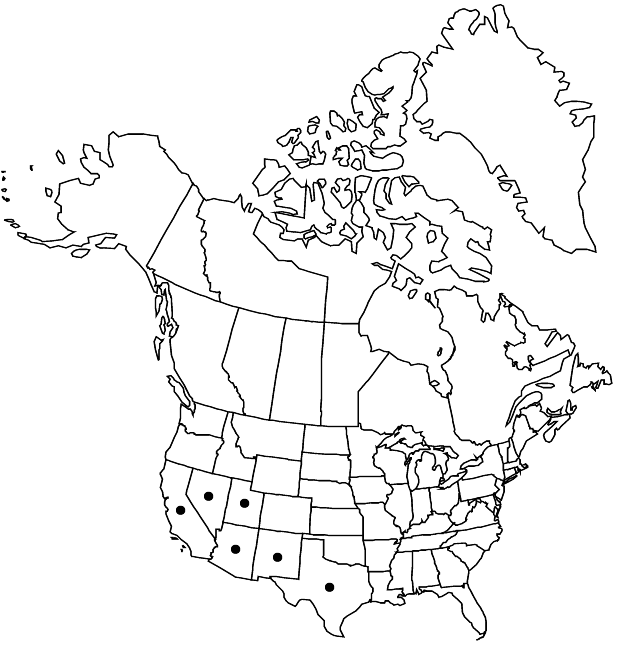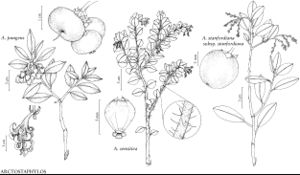Difference between revisions of "Arctostaphylos pungens"
in A. von Humboldt et al., Nov. Gen. Sp. 3(fol.): 218.
3(qto.): 278.
plate 259. 1819 ,.
FNA>Volume Importer |
FNA>Volume Importer |
||
| Line 16: | Line 16: | ||
|name=Arctostaphylos benitoensis | |name=Arctostaphylos benitoensis | ||
|authority=Roof | |authority=Roof | ||
| − | }}{{Treatment/ID/Synonym | + | }} {{Treatment/ID/Synonym |
|name=Arctostaphylos pseudopungens | |name=Arctostaphylos pseudopungens | ||
|authority=Roof | |authority=Roof | ||
| Line 34: | Line 34: | ||
|elevation=300-2600 m | |elevation=300-2600 m | ||
|distribution=Ariz.;Calif.;Nev.;N.Mex.;Tex.;Utah;Mexico. | |distribution=Ariz.;Calif.;Nev.;N.Mex.;Tex.;Utah;Mexico. | ||
| − | |discussion=<p>Arctostaphylos pungens is one of the most widespread species in western North America, and extends south to Oaxaca, Mexico. In most western states, it is found in open pine forests and pinyon-juniper woodlands, generally at higher elevations. In California, it is a chaparral species that occurs in desert and peninsular ranges of southern California mountains and has three disjunct populations in central California in San Benito and Monterey counties. These disjunct populations have been given other names, A. benitoensis and A. pseudopungens, but overall populations are A. pungens.</p> | + | |discussion=<p><i>Arctostaphylos pungens</i> is one of the most widespread species in western North America, and extends south to Oaxaca, Mexico. In most western states, it is found in open pine forests and pinyon-juniper woodlands, generally at higher elevations. In California, it is a chaparral species that occurs in desert and peninsular ranges of southern California mountains and has three disjunct populations in central California in San Benito and Monterey counties. These disjunct populations have been given other names, A. benitoensis and A. pseudopungens, but overall populations are <i>A. pungens</i>.</p> |
|tables= | |tables= | ||
|references= | |references= | ||
| Line 58: | Line 58: | ||
|publication year=;; | |publication year=;; | ||
|special status= | |special status= | ||
| − | |source xml=https://jpend@bitbucket.org/aafc-mbb/fna-data-curation.git/src/ | + | |source xml=https://jpend@bitbucket.org/aafc-mbb/fna-data-curation.git/src/8f726806613d60c220dc4493de13607dd3150896/coarse_grained_fna_xml/V8/V8_772.xml |
|subfamily=Ericaceae subfam. Arbutoideae | |subfamily=Ericaceae subfam. Arbutoideae | ||
|genus=Arctostaphylos | |genus=Arctostaphylos | ||
Revision as of 18:08, 18 September 2019
Shrubs, erect, 1–3 m; burl absent; bark on older stems persistent, reddish, smooth; twigs sparsely short-hairy. Leaves erect; petiole 4–8 mm; blade bright or dark green, shiny, elliptic to lanceolate-elliptic, 1.5–4 × 1–1.8 cm, base obtuse to cuneate, sometimes rounded, margins entire, plane, surfaces smooth, finely tomentose, glabrescent. Inflorescences racemes, simple or 1-branched; immature inflorescence pendent, axis 0.5–1.5 cm, 1+ mm diam., sparsely short-hairy; bracts recurved and crowded at tip, (light green), scalelike, ovate-deltate, (clublike), 2–4 mm, apex acuminate, surfaces glabrous. Pedicels 5–10 mm, glabrous. Flowers: corolla white, conic to urceolate; ovary glabrous. Fruits depressed-globose, 5–8 mm diam., glabrous. Stones distinct. 2n = 26.
Phenology: Flowering winter–early summer.
Habitat: Open pine forests, pinyon-juniper woodlands, chaparral
Elevation: 300-2600 m
Distribution

Ariz., Calif., Nev., N.Mex., Tex., Utah, Mexico.
Discussion
Arctostaphylos pungens is one of the most widespread species in western North America, and extends south to Oaxaca, Mexico. In most western states, it is found in open pine forests and pinyon-juniper woodlands, generally at higher elevations. In California, it is a chaparral species that occurs in desert and peninsular ranges of southern California mountains and has three disjunct populations in central California in San Benito and Monterey counties. These disjunct populations have been given other names, A. benitoensis and A. pseudopungens, but overall populations are A. pungens.
Selected References
None.
